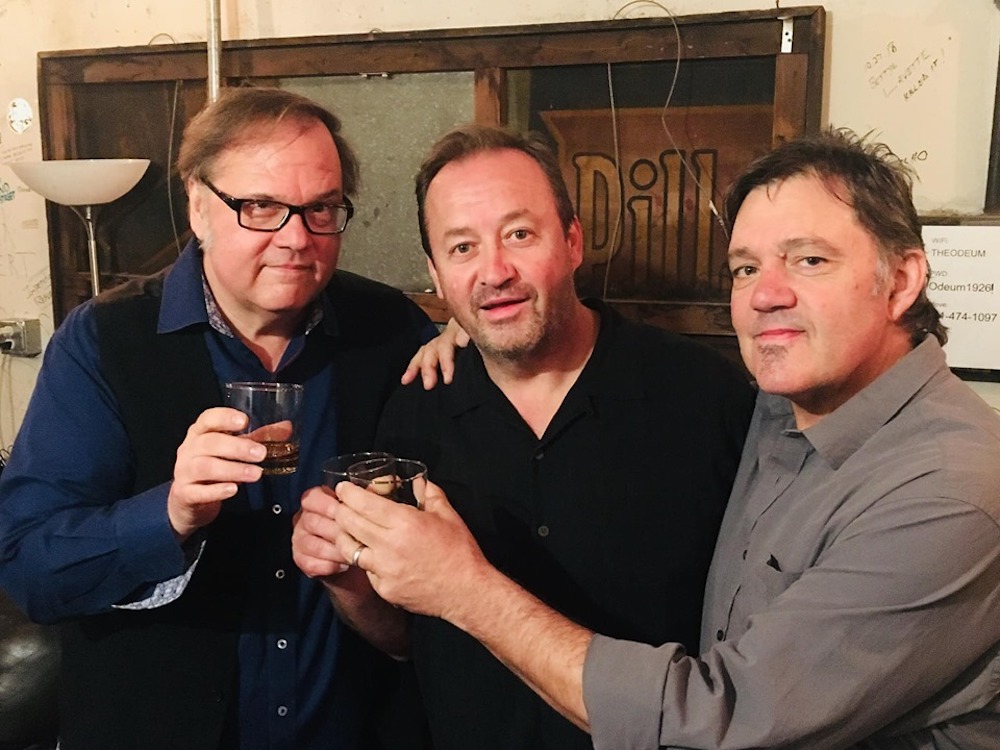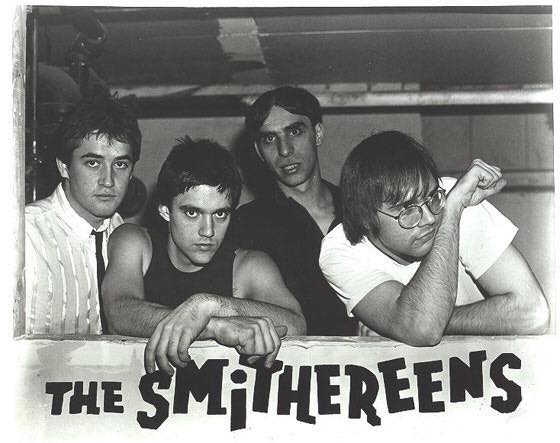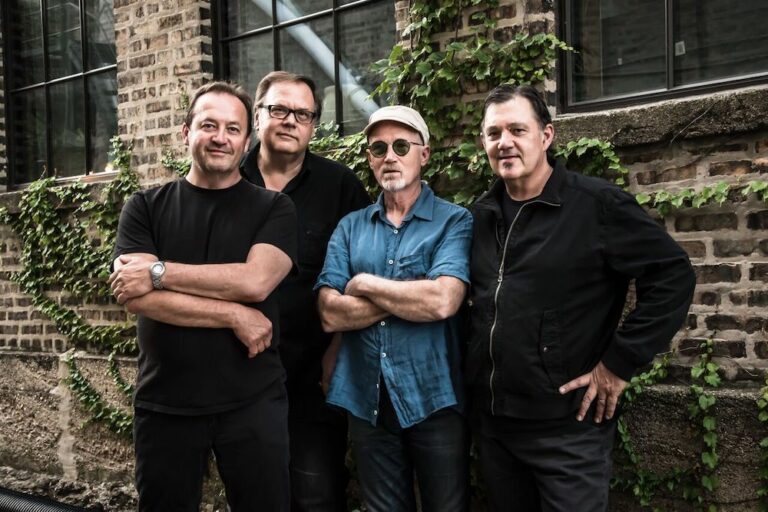More than four decades into their career, The Smithereens are still going strong.
Formed in 1980 in New Jersey, The Smithereens first tasted success six years later with the hypnotic single “Blood and Roses,” which became a staple on mainstream rock and college radio. A string of popular albums followed, containing well-known hits like “Only a Memory,” “A Girl Like You,” and “House We Used to Live In.”
The Smithereens’ no-frills, pop-tinged rock tunes and reputation for fiery live shows created a loyal following worldwide. Wherever their travels took them, singer/guitarist Pat DiNizio, drummer Dennis Diken, lead guitarist Jim Babjak, and bassist Mike Mesaros proudly wore their Jersey roots on their sleeve.
Following DiNizio’s death in 2017, the band has carried on using guest vocalists, primarily Marshall Crenshaw and Robin Wilson (of Gin Blossoms fame). Both vocalists will share the stage during The Smithereens’ upcoming show in New York City on April 29.
Recently, I caught up with Diken to talk about the past, present, and future of the band. In addition to his duties with The Smithereens, Diken is an erudite musical historian, seasoned session drummer, and an accomplished DJ – he hosts a weekly show known as “Denny’s Den” on WFMU radio – and is always keen to discuss music.
In a lengthy phone chat, we discussed The Smithereens’ current run of shows, their Garden State origins, Diken’s memories of performing with legendary vocalist Ronnie Spector, and other topics.
Hey, Dennis… thanks for chatting with me today. I’m a longtime fan of The Smithereens so it’s definitely an honor to speak with you. I know that The Smithereens have a long history with us. From what I understand, that was how you, Jim Babjak, and Mike Mesaros first connected with Pat DiNizio as a singer, through a classified ad in The Aquarian.
That’s right. It was 1978. Jim, Mike, and myself had been playing together for years, trying to find a lead singer that was sympathetic to our sensibilities and our tastes. It was really kind of tough. We put an ad out looking for a singer. Simultaneously, Pat was in a cover band and he put out an ad as they were looking for a drummer. The ad that Pat took out said “Cover band looking for a drummer playing Buddy Holly, The Jam, Elivs Costello, the Bealtes, Devo.” I thought, “Well, this is interesting.” So, I called the number and Pat answered, and I decided I’d go check it out. I joined that band – it was called The Like – but it existed for only about six months. I stayed in touch with Pat and then shortly after that he started writing songs and called me to play on the demos. It wasn’t until that band split up that Pat really started to concentrate on his own material. I brought in Jimmy and Mike to that band and that’s how we became a foursome.
And the rest is history, as they say. You officially became known as The Smithereens in 1980 but it’s amazing how much longer than that you’ve been playing with Jim and Mike.
Jimmy and I have been playing together since 1971, and Mike started playing bass with us in 1975. During that time, I was also playing with some other bands. The three of us never gave up our thing – we were trying to forge ahead, but without having a fourth member, we couldn’t really get it moving.
It’s clear that Pat was the missing ingredient that brought it all together for you. Since Pat’s death in 2017, The Smithereens have continued to perform with guest vocalists such as Robin Wilson and Marshall Crenshaw. What’s it like alternating between different singers like that? Each guy has a slightly different style, so the shows can have a different vibe depending on who is fronting the band.
That’s a good question. I don’t know if we think about it too much. Even with Pat not being there, I still feel that the essence, the sound of the band is intact. If Jimmy hits a chord, he has a unique way of voicing what he’s playing in his chords. Like any good musician, he has a unique way of expressing himself that sets him apart. As long as Jimmy hits a chord and I hit a snare drum as only he and I can do, that is essentially the sound of The Smithereens.
On April 29, The Smithereens are playing Sony Hall in New York City. Have you ever performed there before?
We did play Sony Hall right before COVID. I’ve got to tell you – it’s one of the better venues in the city. It’s an old ballroom in a hotel and it’s really spectacular. They haven’t “ruin-ovated” it, which is a term that my wife and I use for when older places are renovated but they take the character and soul out of it. [Laughs] They really made it into something special. The sound is stellar and the stage… the lighting is really superb. We had an amazing show there a couple of years ago, so we’re really looking forward to going back.

In general, how does it feel to be playing shows again after a lengthy period of not touring due to the pandemic?
It’s like being a race horse caged up and waiting to hit the turf. It’s funny, because I didn’t really play drums during the lockdown at all. Last spring, I played a private party with some friends. Not having played for about a year, I wondered if I’d even still be able to [Laughs]. I didn’t know if I’d be super rusty, but I was surprised to see that I wasn’t. We’ve been doing this long enough, it’s like riding a bike – it just comes back to you. This virus threw everybody into a tailspin. Thankfully, it seems like we can emerge again to a large degree, but still with some caution. It’s nice to be back out in the world again.
What’s something that has really stood out to you about your recent shows?
It’s great to see that people are coming out, and that they’re hungry for entertainment after being locked up for so long. It’s heartening to see that our fans are still there for us. It really means a lot. Let’s be honest, if people don’t stick with you, there’s no band. We’re lucky in that we have a very loyal and dedicated following. What really has come to the forefront in the last 10 or 15 years is that the people who used to come see us in their college days now have grown-up children of their own. They’re free to come back out and relive the joy of their youth. That’s a cool thing.
I really enjoy your radio show on WFMU. You play a lot of fairly obscure artists and records that I wouldn’t have discovered if not for your show.
Oh, thank you so much for listening. I really do believe that there’s no other type of radio station or entity like WFMU. The thing that’s great about WFMU is there’s so much diversity in their programming. There’s something for everyone. When I was a kid, if you asked me what I wanted to be when I grew up, I knew I wanted to play drums but even more than that, I wanted to be a DJ. So, I’ve really had some fun with that.
What other side projects do you have going on these days?
I recently put out a song on Bandcamp with a video accompanying it, called “Bear (In My Garden).” It’s a track from 2010 that I recorded for Bear Family Records – a label that does reissue work and the most exhaustive and scholarly box sets you’re going to see on country, rockabilly, and rock & roll artists. In 2010, they were planning a limited edition box set commemorating their 35th birthday. They called a bunch of artists and asked them to contribute a bear-themed song to the project. At the time in Jersey, there were a lot of reports of bears jumping into people’s backyards and rummaging through their garbage, so the lyrics at the time reflected that. Looking at it now, the lyrics took on a different meaning with the bear signifying Russia and the garden meaning Ukraine. I put the song out there online and proceeds of the download go to benefit the people of Ukraine.
How nice that the song ended up being a fundraiser for Ukraine. As for other recordings, I heard that The Smithereens will have a new album out either late this year or early next year, the band’s first new material since 2011.
We’re planning on recording at some point this year. There is material written and we’re working on some more. We just need to set a date, really. It’s time. We also have a lot of archival material that’s going to be coming out, as well – unreleased tracks, live recordings.

Sadly, rock icon Ronnie Spector passed away a few months ago. I know that you recorded with her and spent time as her touring drummer. What are some of your favorite memories of your time performing with Ronnie?
It was so much fun. In the early sixties, that was when I really started listening to the radio. Hearing the drum performances on records by The Four Seasons, Beach Boys, Jan and Dean, Leslie Gore, and the Phil Spector records, that made me want to play drums. “Be My Baby” was a big, big record for me growing up. When it came to playing with Ronnie, it was really a dream come true. Any time I took the stage with her, I never let go of feeling how cool it was to be up there with her and to hear her voice coming through my monitor, that one-of-a-kind voice. It was always something very meaningful to me to be able to play those grooves that I loved so much and she made it clear to me that she really appreciated what I brought to the band.
I think a lot of people forget the fact that Ronnie’s career had a deep connection to New Jersey. When she was attempting to jump-start a solar career in the seventies, she was assisted by Steven Van Zandt and Bruce Springsteen and immersed herself in the Asbury Park music scene.
That’s true. That record she made with Southside Johnny got so much airplay on New York radio when it came out. She really has that connection with New Jersey. It does get overlooked.
Speaking of New Jersey, last year The Smithereens performed at the grand opening of the new performing arts center in Carteret. As musicians who grew up in that town, how special was that night for you?
It was really special. On that block where the performing arts center now stands, there used to be stores there. Years ago, there was a place called Little Klein’s. It was basically a candy store and they sold stationery, school supplies, magazines, and comic books. We used to ride our bikes to that very location to buy Mad magazine and comic books and candy. That location is very special to us. If you had told us when we were 11 or 12 years old that we would be in a band and would be playing at a venue there, I don’t know if we would have believed it. It’s kind of mind blowing.
You met Jim Babjak as a freshman at Carteret High School. How did you two first meet and hit it off?
I got my first drum set in 1968, but I didn’t really find other musicians to play with until after eighth grade. My criteria was, if I could meet a guitarist who could play “I Can’t Explain” by The Who, that would be a good starting point. That was really the direction I wanted to go in. I thought that when I went to high school, there would be all these kids coming together from different school districts and my chances would be better to find someone who shares my musical sensibility. So, day one, period one of high school, there’s a kid sitting in front of me – he had kind of a Beatles haircut and he opened up his loose leaf and inside his binder were color photos of The Who plastered in there. I thought, “I really need to talk to this kid.” It was Jimmy. It was the first class of the first day of high school. I spoke to him that day and we started playing together that week.
More than 50 years after that meeting, you guys are still in a band together. Did you ever imagine back then that could be possible?
I think in a weird way, I did. We hit it off so well, musically and personally. We became best friends. That’s why it took so long for The Smithereens to coalesce. I knew I wanted to play with Jimmy, and then when Mike started playing with us, we felt that this is what we’re going to do. Even if it was unspoken, that’s why we stuck with it. I do think the chemistry of the band has everything to do with longevity.
We still have the same zest, the same sense of fun and passion for the music, that we did back then. Onstage recently, I said that we grew up listening to records together, going to concerts together, and learning to play together. I said to the audience, “it turned into this, what you see onstage.” It’s really just an extension of that passion that we’ve had since we were little kids. It’s something that we don’t take lightly and I think that comes across in our performance. We really don’t phone it in. We really have a good time when we play. I think that’s one reason why our fans have stuck with us.
THE SMITHEREENS WILL PERFORM AT SONY HALL IN NYC ON APRIL 29! FOR TICKETS AND INFORMATION, VISIT THEIR WEBSITE!



